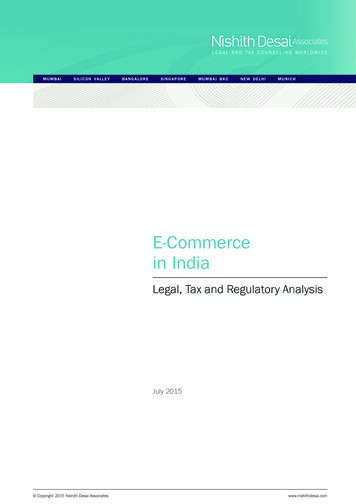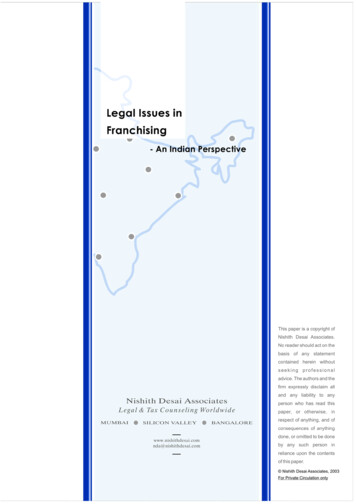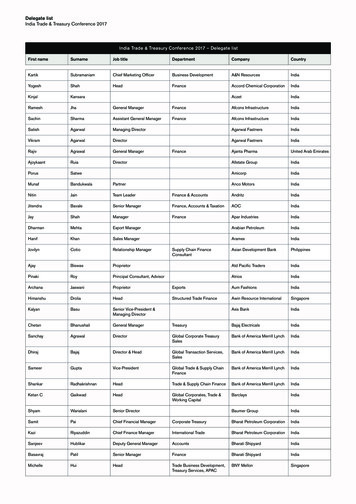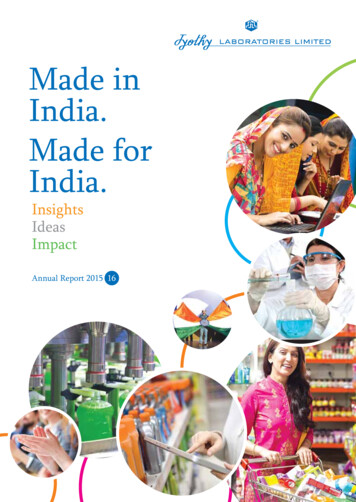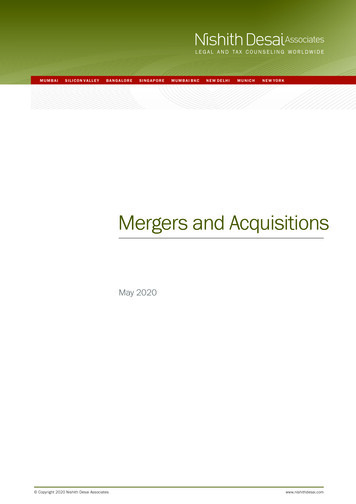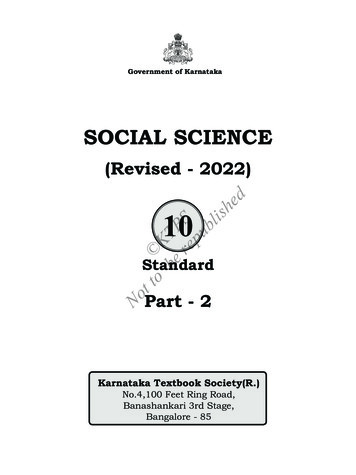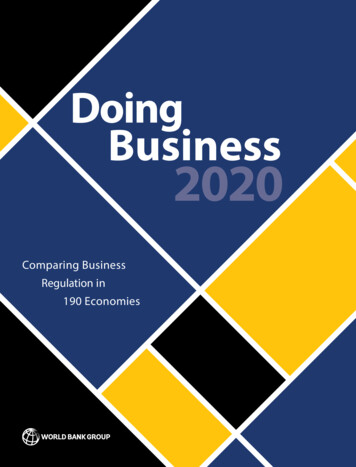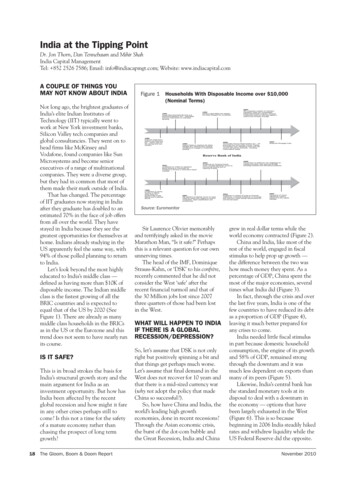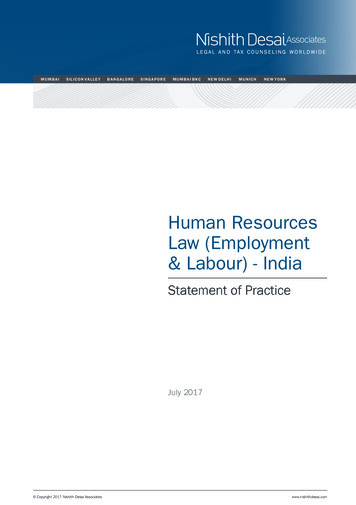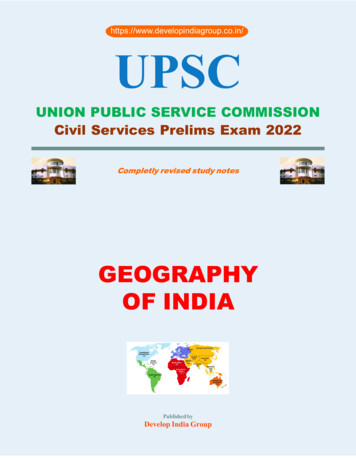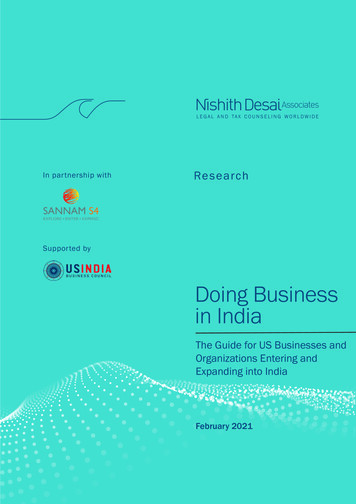
Transcription
In partnership withRe s ea rchSupported byDoing Businessin IndiaThe Guide for US Businesses andOrganizations Entering andExpanding into IndiaFebruary 2021
Doing Business in IndiaThe Guide for US Businesses and OrganizationsEntering and Expanding into IndiaFebruary 2021In partnership withSupported by:For any help or assistance please email us on ndaconnect@nishithdesai.comor visit us at www.nishithdesai.comDMS Code: #572921 Nishith Desai Associates 2021
Doing Business in IndiaThe Guide for US Businesses and Organizations Entering and Expanding into IndiaForewordsAt Nishith Desai Associates (NDA), we are fired by purpose, innovation and the will to change the world, Apotentfuel to this end, has been our relentless focus on Research and Knowledge.Anticipating future trends, developing knowhow and insights, and being prepared and inventive with robust legalsolutions before their time arrives, has been the hallmark, discipline and anchor for our legal practice. Moreover,we believe in being a true ‘open source firm’, voraciously sharing the knowledge we glean and assimilate.As an India-centric global law firm (with over 70% of our clients being international), our firm has,for over threedecades, been the first port of call for businesses and companies looking at entering, setting up and buildingbusinesses in India. We have been trusted advisors, handheld our clients as they navigated their path into theIndian market, grown with them, kept them at a strategic advantage and ahead of any legal, tax or regulatorychallenges that may have emerged.It would be fair to say, unravelling the trajectory of India’s business climate, its legal, tax and regulatory mires,interpreting, synthesizing and demystifying the ‘what, why, how’ of it all, is NDA’s comfort zone. We rigorouslypursue every thread and dimension which can impact our existing and potential clients.I am delighted therefore to bring to you this extraordinary body of knowhow – call it a guide or encyclopedia – oneverything you need to know if you are (especially) based in the US and doing (or seeking to do) business in India.‘Doing Business in India’(DBI) is the most composite and comprehensive repository of all information you musthave handy while running a trade or business in India.A deep-dive by NDA’s experts along with our partner, Sannam S4,DBI offers precise, thorough and detailedguidance on India’s legal system; investing, setting up and operating in India; tax considerations in structuringinvestments; Mergers & Acquisitions and Capital Markets; IP, employment, environmental and disputeresolution regulations, among others.We especially draw from our notable industry prowess in financial services, TMT and Pharma Healthcare.Reputed for our ‘Advanced Predictive legal practice’ we constantly conduct original research into emerging areasof the law - Blockchain, 5G, Artificial Intelligence, Designer Babies, Flying Cars, Autonomous vehicles, IOT, AI &Robotics, Medical Devices, Genetic Engineering, Drones, 3D Printing amongst others – we enjoy high credibilityin respect of our independent research and assist number of ministries in their policy and regulatory work.I want to thank the US-India Business Council for organizing the launch of this book at the inaugural event of the“Accelerate to 500” series focusing on the target of 500 billion two-way trade in the US-India corridor.For sure, India’s business climate is exciting and inviting. One chapter we regret not incorporating in this work– but worth a watch - is on Special Purpose Acquisition Company (SPAC). (We hope to bring out a separatepublication in this regard to share our experiences.) I am particularly thrilled with the segment on GujaratInternational Financial Tec-City (GIFT City), India’s first offshore-mid shore, International Financial ServiceCenter (IFSC), which shall surely propel India as a global financial hub.I trust you will benefit and wish you all success doing business in India!Sincerely,Nishith Desainishith.desai@nishithdesai.com Nishith Desai Associates 2021
Provided upon request onlyAdrian Mutton,Founder and CEO, Sannam S4Predictions by the UN’s Population Division suggest that by 2027 India will surpass China as the world’s largestpopulation. By 2050, India will become the world’s second largest economy, after China and directly ahead of theUnited States, reports suggest. Regardless of the impact of the coronavirus pandemic, India will make an indeliblemark on the 21st Century and, given geopolitical forces in the region, India’s partnership with the United Stateswill become stronger both strategically and economically.Recent efforts by the Indian Government have improved ease of doing business in India, making the market moreaccessible to foreign investors, businesses and organizations interested in expanding their products, services, andmissions in the Indo-Pacific Region. India’s ranking in the World Bank’s Ease of Doing Business Index currentlysits at 63, a remarkable leap forward of 79 positions in just five years. Technology, service and manufacturingmodernization is at the forefront of India’s growth. Significant measures have been taken to bring businessadministration e.g. registrations and tax filings onto digital platforms, streamlining processes and reducingopportunities for graft.While India’s investment promotion body, Invest India, continues to implement significant measures to attractinvestment, India can be a complex country to outsiders. Each of India’s states are attractive (and large) marketsunto themselves, many with their own distinct cultures, language and consumer preferences. Along similarlines, the British economist Joan Robinson also famously observed: “Whatever you can rightly say about India,the opposite is also true.” A one-size-fits-all approach rarely works for India challenging companies to localizetheir products and services in order to capture meaningful market share. Receiving clear guidance and practicaladvice and support while also investing the necessary time and resources to understand the market is essential tosucceeding.As an India specialist market entry firm, our role is to provide the on-the ground, practical support our clientsneed to effectively deal with the many nuances of doing business in and across the country. Our trusted localadvice is backed by our expert in-house implementation capabilities, ensuring that our clients have a consistentand dependable partner by their side to ensure they make the most of this dynamic and exciting market. Frompre market entry planning, to dealing with the administration of establishing a local presence and preparing toscale, through helping with the hiring, firing and retention of talent and identifying your best route to market,our US and local India teams will work hand-in-hand with you to mitigate risks and ensure you are well placed tosucceed.We are proud to partner with Nishith Desai Associates, the US India Business Council, and Invest India to releasethis Doing Business in India Guide. Thank you to all of my colleagues and the Nishith Desai Associates teamfor their thoughtful inputs. Our aim is that this Guide can be a resource to the many American businesses andorganizations interested in participating in this 21st Century opportunity.Sincerely,Adrian Mutton Nishith Desai Associates 2021
Doing Business in IndiaThe Guide for US Businesses and Organizations Entering and Expanding into IndiaNisha BiswalPresident of the U.S.-India Business Council and Senior Vice President for South Asia at the U.S. Chamber of Commerce.The fast evolving and moving United States – India partnership is founded on common set of values, robustdemocratic systems, and on deep cultures of entrepreneurship. Our countries also enjoy longstanding peopleto-people ties that make them natural strategic partners. As leaders around the globe reassess their approach toglobal trade and investment and recover from disrupted supply chains, both nations have the capacity to catalyseareas of growth to achieve the shared goal of US 500 billion in two-way trade. This will require a strategic look atmarket-based reforms, deeper cooperation in research and development and a dynamic assessment of key sectorsthat need a targeted boost within the bilateral economic relationship.Though the trade trajectory has been positive, there is still significant untapped potential in the U.S-Indiacommercial relationship. Trade between our two countries reached nearly 150 billion in 2019, but themaximum potential can be reached by fostering a deeper connect between small and medium businesses atthe state and local level of both the countries. As part of the U.S. Chamber of Commerce, USIBC is linked to anetwork of thousands of state, city, and metro chambers of commerce and will continue to leverage its networksfor delivering value to its members and the larger business community across states and cities in both countries.USIBC is committed to supporting American businesses make their first forays into India and be a critical leaderto increase bilateral trade and investment.I congratulate Nishith Desai Associates and Sannam S4 for taking the initiative to author the “Doing Business in India”report. Investment guides like the “Doing Business in India” are excellent resources for businesses that are evaluatingIndia as a viable option and are critical towards the achievement of the 500 billion goal in two-way trade.Sincerely,Nisha Biswal Nishith Desai Associates 2021
Doing Business in IndiaThe Guide for US Businesses and Organizations Entering and Expanding into IndiaAbout NDAWe are an India Centric Global law firm (www.nishithdesai.com) with four offices in India and the only law firmwith license to practice Indian law from our Munich, Singapore, Palo Alto and New York offices. We are a firm ofspecialists and the go-to firm for companies that want to conduct business in India, navigate its complex businessregulations and grow. Over 70% of our clients are foreign multinationals and over 84.5% are repeat clients.Our reputation is well regarded for handling complex high value transactions and cross border litigation; thatprestige extends to engaging and mentoring the start-up community that we passionately support and encourage.We also enjoy global recognition for our research with an ability to anticipate and address challenges from astrategic, legal and tax perspective in an integrated way. In fact, the framework and standards for the AssetManagement industry within India was pioneered by us in the early 1990s, and we continue remain respectedindustry experts.We are a research based law firm and have just set up a first-of-its kind IOT-driven Blue Sky Thinking & ResearchCampus named Imaginarium AliGunjan (near Mumbai, India), dedicated to exploring the future of law & society.We are consistently ranked at the top as Asia’s most innovative law practice by Financial Times. NDA is renownedfor its advanced predictive legal practice and constantly conducts original research into emerging areas of the lawsuch as Blockchain, Artificial Intelligence, Designer Babies, Flying Cars, Autonomous vehicles, IOT, AI & Robotics,Medical Devices, Genetic Engineering amongst others and enjoy high credibility in respect of our independentresearch and assist number of ministries in their policy and regulatory work.The safety and security of our client’s information and confidentiality is of paramount importance to us. To thisend, we are hugely invested in the latest security systems and technology of military grade. We are a sociallyconscious law firm and do extensive pro-bono and public policy work. We have significant diversity with femaleemployees in the range of about 49% and many in leadership positions. Nishith Desai Associates 2021
Provided upon request onlyAccoladesA brief chronicle our firm’s global acclaim for its achievements and prowess through the years –§Benchmark Litigation Asia-Pacific: Tier 1 for Government & Regulatory and Tax2020, 2019, 2018§Legal500: Tier 1 for Tax, Investment Funds, Labour & Employment, TMT and Corporate M&A2020, 2019, 2018, 2017, 2016, 2015, 2014, 2013, 2012§Chambers and Partners Asia Pacific: Band 1 for Employment, Lifesciences, Tax and TMT2020, 2019, 2018, 2017, 2016, 2015§IFLR1000: Tier 1 for Private Equity and Project Development: Telecommunications Networks.2020, 2019, 2018, 2017, 2014§ AsiaLaw Asia-Pacific Guide 2020: Tier 1 (Outstanding) for TMT, Labour & Employment, Private Equity,Regulatory and Tax§FT Innovative Lawyers Asia Pacific 2019 Awards: NDA ranked 2nd in the Most Innovative Law Firmcategory (Asia-Pacific Headquartered)§RSG-Financial Times: India’s Most Innovative Law Firm 2019, 2017, 2016, 2015, 2014§ Who’s Who Legal 2019:Nishith Desai, Corporate Tax and Private Funds – Thought LeaderVikram Shroff, HR and Employment Law- Global Thought LeaderVaibhav Parikh, Data Practices - Thought Leader (India)Dr. Milind Antani, Pharma & Healthcare – only Indian Lawyer to be recognized for ‘Life sciences-Regulatory,’for 5 years consecutively§Merger Market 2018: Fastest growing M&A Law Firm in India§ Asia Mena Counsel’s In-House Community Firms Survey 2018: The only Indian Firm recognized for LifeSciences§IDEX Legal Awards 2015: Nishith Desai Associates won the “M&A Deal of the year”, “Best DisputeManagement lawyer”, “Best Use of Innovation and Technology in a law firm” and “Best Dispute ManagementFirm” Nishith Desai Associates 2021
Doing Business in IndiaThe Guide for US Businesses and Organizations Entering and Expanding into IndiaPlease see the last page of this paper for the most recent research papers by our experts.DisclaimerThis report is a copyright of Nishith Desai Associates. No reader should act on the basis of any statementcontained herein without seeking professional advice. The authors and the firm expressly disclaim all and anyliability to any person who has readt his report,or otherwise, in respect of anything, and of consequences ofanything done, or omitted to be done by any such person in reliance upon the contents of this report.ContactFor any help or assistance please email us on ndaconnect@nishithdesai.comor visit us at www.nishithdesai.comAcknowledgementsShreya Shenolikarshreya.shenolikar@nishithdesai.comDarren Punnendarren.punnen@nishithdesai.comKrithika Rameshkrithika.ramesh@nishithdesai.comPayel Chatterjeepayel.chatterjee@nishithdesai.comDr. Milind Antanimilind.antani@nishithdesai.com Nishith Desai Associates 2021
Provided upon request onlyAbout Sannam S4Sannam S4 is a leading global market entry firm supporting businesses and organizations in building sustainableand compliant operations internationally. Founded in 2008, Sannam S4 has qualified and dedicated professionalsacross finance, accounting, payroll, tax, compliance, HR and marketing disciplines in order to provide anintegrated professional services solution that simplifies market entry and expansion for its partners.Sannam S4 has developed particular depth and expertise across the South and Southeast Asia regions,leveraging market entry experts in the United States as well as technical in the region to provide advisory andimplementation support. The firm supports many of the world’s leading research universities as well as globallyambitious businesses and nonprofit organizations as they explore, enter and expand their missions.Sannam S4 is recognized as a market leader in its field, winning Consultancy of the Year Award multiple timesfrom India Inc. during its UK-India Week Awards.For more information about Sannam S4, please visit www.sannamS4.com. Nishith Desai Associates 2021
Doing Business in IndiaThe Guide for US Businesses and Organizations Entering and Expanding into IndiaAbout USIBCThe U.S.-India Business Council represents top global companies operating across the United States, India, andthe Indo-Pacific. Amid dynamic growth within the U.S.-India commercial partnership, we serve as the premiervoice of industry and create connections between businesses and governments across both countries. Through ourflagship Washington, D.C. and New Delhi offices and presences across both countries, we work with members toidentify and advance key policy priorities. Recognizing that U.S.-India trade is increasingly driven by new businesshubs, USIBC is also focused on strengthening connections between cities and states. Nishith Desai Associates 2021
Doing Business in IndiaThe Guide for US Businesses and Organizations Entering and Expanding into IndiaContents1.INTRODUCTION012.INDIA’S LEGAL SYSTEM03I.II.III.IV.030303043.4.INVESTMENT INTO INDIA06I.II.III.IV.Foreign Direct InvestmentDownstream InvestmentAdditional Procedural RequirementsOther Foreign Investments07141516ESTABLISHING A PRESENCE IN I.5.6.Nature of the Constitution of IndiaDivision of Legislative Powers between the Centre and StatesDelegated LegislationCourt System in India – Hierarchy of CourtsSetting Up Unincorporated EntitiesEstablishment of Incorporated EntitiesIncorporation Process (As per Companies Act, 2013)International Financial Services Centre / GIFT CityTypes of Securities IssuedReturn on InvestmentsImportant Issues under the Companies Act, 2013Companies (Amendment) Act, 2015 and further changes to theCompanies Act, 2013Companies (Amendment) Act, 2017 and further changes to theCompanies Act, 2013Companies (Amendment) Act, 2019 and further changes to theCompanies Act, 2013Setting Up and Operating in India32333535MERGERS AND ACQUISITIONS39I.II.III.IV.V.VI.VII.VIII.Companies Act, 2013Takeover CodeListing RegulationsInsider Trading RegulationsCompetition LawExchange Control RegulationsOverseas Direct InvestmentApplicable Taxes and Duties3941424244464647CAPITAL MARKETS IN ublic OfferingsPreferential AllotmentQualified Institutional PlacementsRecent Relaxations to Stressed CompaniesOverseas Listing of Indian CompaniesListing of Foreign Companies in IndiaSmall and Medium Listing Enterprises (SME)Issue and Listing of Depository Receipts Nishith Desai Associates 2021
Provided upon request onlyIX.X.7.8.9.Capital RaisingPromoter’s Contribution and Lock-in6161TAX CONSIDERATIONS IN STRUCTURING INVESTMENTS62I.II.III.IV.62707275Corporate TaxStructuring InvestmentsIndirect TaxationTDS Obligations on E-Commerce OperatorsHUMAN 686Employment LegislationsEmployment DocumentationRecruitment and Salary BenchmarkingOnboardingEmployee ManagementPayrollPerformance ManagementOffboardingINTELLECTUAL al Conventions and TreatiesPatentsCopyrightsTrademarksTrade SecretsDesigns10. PRIVACY AND DATA PROTECTIONI.III.Current FrameworkRecent Focus on Non-Personal Data Governance11. ENVIRONMENTAL LAWSI.II.III.IV.Environment (Protection) Act, 1986Air & Water ActMunicipal AuthoritiesLitigation & Penalty12. DISPUTE RESOLUTION IN INDIAI.II.III.IV.V.VI.VII.VIII.IX.Judicial Forums – Courts and TribunalsJurisdictionLaw on Interim ReliefSpecific ReliefLaw on DamagesDispute Resolution by ArbitrationEnforcement of Arbitral AwardsEnforcement of Foreign Judgments in IndiaAn Overview of Insolvency and Bankruptcy13. TRADE WITH INDIAI.II.Trade ModelsImplications Under Tax Laws Nishith Desai Associates 114115117117119
Doing Business in IndiaThe Guide for US Businesses and Organizations Entering and Expanding into IndiaIII.IV.Customs DutySpecial Schemes14. SECTOR-SPECIFIC REGULATIONSI.II.Healthcare SectorEducation Sector11912012312312415. CONCLUSION12616. INVESTING INTO INDIA: CONSIDERATIONS FROM A MAURITIUS-INDIATAX PERSPECTIVE128I.II.Mauritius - India Relations: BackgroundMauritius - India Tax Treaty: Special Considerations17. INVESTING INTO INDIA: CONSIDERATIONS FROM A SINGAPORE-INDIATAX PERSPECTIVEI.II.Singapore - India Relations: BackgroundSingapore - India Tax Treaty: Special Considerations18. INVESTING INTO INDIA: CONSIDERATIONS FROM A UNITED STATES OFAMERICA-INDIA TAX PERSPECTIVEI.II.US - India Relations: BackgroundUS - India DTAA: Special Considerations Nishith Desai Associates 2021128129134134135139139140
Doing Business in IndiaThe Guide for US Businesses and Organizations Entering and Expanding into India1. IntroductionSince the starting of economic liberalization in India in 1991, India has emerged as a top destination forinvestments globally. In terms of its economic growth, India is one of the fastest growing large economies andexperts are predicting that if India maintains its momentum soon it will be the fastest growing economy of theworld. While COVID-19 disrupted the growth path in 2020, India is expected to roar back to annual growth ofmore than 7% each year in coming five years.1This increase in the economic growth in India is primarily attributed to the sweeping changes that have beenushered in by the reformes brough by governments both at the central (similar to to the federal level in the US)and state levels. Some of the most prominent reforms and changes are as follows.§Introduction of a unified indirect tax law system.§Introduction of insolvency and bankruptcy code to turn around stressed assets.§Improvement in the flow of money in the economy primarily through banking and financial institutions.§ Stabilization of government’s outlook towards imposing taxes on foreign investors.§Liberalization of the framework for foreign investment.The state and central governments have been proactive in enhancing the attractiveness of India as a globalbusiness destination by introducing new laws and policies and prioritizing their implementation. The goal is tomake India a desirable avenue for businesses and aligning them with the socio-economic progress. This evolutionof laws has led to a significant growth of India, as a global economy.To increase the ease of doing business in India, the Government of India has also set up a special agency, NationalInvestment Promotion & Facilitation Agency (“Invest India”). Invest India provides valuable information aboutkey sectors and states of India, which is very useful for foreign businesses and organizations looking to expandinto India.2The biggest testament of effectiveness of all the initiatives and changes that have been introduced by thegovernment is India’s continuous scaling up to a greater ranking in in the World Bank’s ease of doing businessreport. In 2020, India jumped 14 positions and is now ranked 63rd for doing business in India.3On February 1, 2021, the Indian Finance Minister (FM), Nirmala Sitharaman, presented the Union Budget(“Budget”) of India for the financial year 2021-22. This was a crucial Budget for the Government, especially againstthe backdrop of the contraction of the GDP caused by the COVID-19 pandemic. We have integrated key reformspresented in the Budget in this book with a special reference.41.Statita (2021). India: Real gross domestic product (GDP) growth rate from 2015 to 2025. mestic-product-gdp-growth-rate-in-india/2.National Investment Promotion & Facilitation Agency. https://www.investindia.gov.in/3.The World Bank (2020). Ease of Doing Business in India. mies/india4.For a comprehensive insight on the Budget 2021, please see our Hotline (February 2, 2021) at -ship.html Nishith Desai Associates 20211
Provided upon request onlyTHE BUDGET 2021: Key Reforms on the Government’s AgendaThe Finance Minister, in her Budget speech, mentioned the intention of the Government to: Introduce a new Securities Law code to consolidate laws under the Securities and Exchange Board of India Act,1992, the Depositories Act, 1996, the Securities Contracts Regulation Act, 1956 and the Government SecuritiesAct, 2007. Establish an Investors’ charter to assimilate the rights of all financial investors across all financial products. Remove the turnover and paid-up capital thresholds for setting up of One Person Companies and dilute theresidence requirement for sole members. If the proposal is adopted, a sole member will be required to remain inIndia for a minimum of 120 days (as opposed to the current requirement of 182 days). NRIs will also be allowed toset up such companies. Increase the cap on the Foreign Direct Investment (“FDI”) in the insurance sector from the current 49 percent to74 percent. Set up an asset reconstruction company (“Bad Bank”) to take over the bad loans of banks. This will enable banksto restructure their balance sheets and increase flexibility in the sector. Start a statutorily-backed and professionally-managed Development Finance Institution (“DFI”) to supportfinancing of long-term projects. It is expected to have a lending portfolio of over US 7 billion within three years. Push for further divestments in government-owned units, including in banking and insurance sectors.This book sheds light on the basic legal regime regarding the conduct of business in India and provides guidanceon commonly raised questions by overseas investors. This book is intended to act as a broad legal guide, with anoverall focus on the multiple facets of law that need to be taken into consideration with the goal of aiding yourdecision making process when deciding to foray in India. However, it should not be used as a legal opinion on anyspecific matter. The laws discussed here are subject to change and the regulatory environment in India is dynamic.We recommend that you obtain appropriate counsel from a qualified lawyer or a law firm before undertaking anyactivity having legal or tax implications. We would be happy to assist you. Nishith Desai Associates 20212
Doing Business in IndiaThe Guide for US Businesses and Organizations Entering and Expanding into India2. India’s Legal SystemIndia has always been a land of mystery in many ways and the Indian legal system is no different. Understandingthe Indian legal system is one of the keys in establishing successful businesses in India.India follows the common law system. Hence, India incorporates essential characteristics of common lawjurisdictions, for instance courts follow previous decisions on the same legal issue and decisions of appellate courtare binding on lower courts. As a result of adopting all these principles, the Indian legal system is akin to theEnglish legal system. However, unlike England, India has a written constitution.I. Nature of the Constitution of IndiaThe Constitution of India (the “Constitution”) is quasi-federal in nature, or one that is federal in character butunitary in spirit. The Constitution possesses both federal and unitary features and can display both of thesefeatures simultaneously despending on requirements of time and circumstances.The federal features of the Constitution include distribution of powers between national (or federal) governmentand government of the various constituent states. There are two sets of governments, one at the central level andthe other at state level. The distribution of powers between governments is enshrined in the Union, State andConcurrent lists of the Constitution.The Constitution also possesses strong unitary features such as the unified judiciary with the Supreme Court atthe apex in India, which is different from the federal principle envisaging a dual system of courts as in the US,and the authority to make appointment of key positions (for example, governors of states, the Chief ElectionCommissioner, the Comptroller and Auditor General, etc.) resting with the central government.II. Division of Legislative Powers between the Centreand StatesThe legislative powers are divided between the federal and state legislature. The Constitution identifies andallocates the “fields of legislation” between the federal and state legislatures through 3 distinct lists:1.the Union List has 100 entries that are exclusively reserved for the federal parliament and includes subjectslike, national defence, incorporation of companies, banking and the RBI etc.;2.the State List has 61 entries that are exclusively reserved for various state legislatures and includes subjectslike, agriculture, land and trade and commerce within the state’s territories; and3.the Concurrent List contains 52 entries and includes subjects such as contracts, bankruptcy and insolvency,trust and trustees etc., on which both the federal and states legislature may legislate; however, in case of aconflict, the federal law shall prevail.III. Delegated LegislationIn addition to the legislative powers conferred on the federal and state legislatures, the Constitution recognises ‘delegatedlegislation.’ This includes the exercise of legislative power by a governmental agency that is subordinate to the legislature. Nishith Desai Associates 20213
Provided upon request onlyAt times, a statute may be incomplete unless it is read with the concomitant delegated legislation. Hence, it isimportant to consider the delegated legislation which includes rules and regulations. Delegated legislation mayalso vary between two states.IV. Court System in India – Hierarchy of CourtsSupreme CourtHigh CourtDistrict Court &Sessions CourtCriminalCivilCivil Judge Senior DivisionCivil Judge Junior DivisionJudicial Magistrate First ClassJudicial Magistrate Second ClassThe Supreme Court of India is the highest appellate court and adjudicates appeals from the state High Courts. TheHigh Courts for each of the states (or union territories) are the principal civil courts of original jurisdiction in thestate (or the union territory), and can try all offences including those punishable with death.The High Courts adjudicate on appeals from lowers courts and writ petitions under Article 226 of theConstitution. There are 25 High Courts in India.
Doing Business in India Nisha Biswal President of the U.S.-India Business Council and Senior Vice President for South Asia at the U.S. Chamber of Commerce. The fast evolving and moving United States - India partnership is founded on common set of values, robust democratic systems, and on deep cultures of entrepreneurship.
